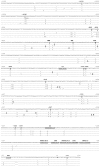Comparative analyses of single-nucleotide polymorphisms in the TNF promoter region provide further validation for the vervet monkey model of obesity
- PMID: 20034434
- PMCID: PMC2798838
Comparative analyses of single-nucleotide polymorphisms in the TNF promoter region provide further validation for the vervet monkey model of obesity
Abstract
Tumor necrosis factor is a cytokine that plays critical roles in inflammation, the innate immune response, and a variety of other physiologic and pathophysiologic processes. In addition, TNF has recently been shown to mediate an intersection of chronic, low-grade inflammation and concurrent metabolic dysregulation associated with obesity and its comorbidities. As part of an ongoing initiative to further characterize vervet monkeys originating from St Kitts as an animal model of obesity and inflammation, we sequenced and genotyped the human ortholog vervet TNF gene and approximately 1 kb of the flanking 3' and 5' regions from 265 monkeys in a closed, pedigreed colony. This process revealed a total of 11 single-nucleotide polymorphisms (SNPs) and a single 4-bp insertion-deletion, with minor allele frequencies of 0.08 to 0.39. Many of these polymorphisms were in strong or complete linkage disequilibrium with each other, and all but 1 were contained within a single haplotype block, comprising 5 haplotypes with frequencies of 0.075 to 0.298. Using sequences from humans, chimpanzees, vervets, baboons, and rhesus macaques, phylogenetic shadowing of the TNF promoter region revealed that vervet SNPs, like the SNPs in related species, were clustered nonrandomly and nonuniformly around conserved transcription factor binding sites. These data, combined with previously defined heritable phenotypes, permit future association analyses in this nonhuman primate model and have great potential to help dissect the genetic and nongenetic contributions to complex diseases like obesity. More broadly, the sequence data and comparative analyses reported herein facilitates study of the evolution of regulatory sequences of inflammatory and immune-related genes.
Figures



Similar articles
-
Single-nucleotide polymorphisms in the TNF gene are associated with obesity-related phenotypes in vervet monkeys.Obesity (Silver Spring). 2011 Jul;19(7):1427-32. doi: 10.1038/oby.2011.19. Epub 2011 Feb 17. Obesity (Silver Spring). 2011. PMID: 21331060
-
Single nucleotide polymorphisms within the promoter region of the rhesus monkey tumor necrosis factor-alpha gene.Immunogenetics. 2005 May;57(3-4):289-92. doi: 10.1007/s00251-005-0799-x. Epub 2005 Apr 20. Immunogenetics. 2005. PMID: 15900501
-
Haplotype analysis of a 100 kb region spanning TNF-LTA identifies a polymorphism in the LTA promoter region that is associated with atopic asthma susceptibility in Japan.Clin Exp Allergy. 2005 Jun;35(6):790-6. doi: 10.1111/j.1365-2222.2005.02265.x. Clin Exp Allergy. 2005. PMID: 15969671
-
Cytokine gene polymorphisms in obstructive sleep apnoea/hypopnoea syndrome.Sleep Med. 2015 Jun;16(6):792-5. doi: 10.1016/j.sleep.2015.01.006. Epub 2015 Apr 7. Sleep Med. 2015. PMID: 25953302
-
Could single-nucleotide polymorphisms (SNPs) affecting the tumour necrosis factor promoter be considered as part of rheumatoid arthritis evolution?Immunobiology. 2006;211(1-2):75-84. doi: 10.1016/j.imbio.2005.09.005. Epub 2005 Dec 27. Immunobiology. 2006. PMID: 16446172 Review.
Cited by
-
Expanding whole exome resequencing into non-human primates.Genome Biol. 2011 Sep 14;12(9):R87. doi: 10.1186/gb-2011-12-9-r87. Genome Biol. 2011. PMID: 21917143 Free PMC article.
-
Obesity and obesogenic growth are both highly heritable and modified by diet in a nonhuman primate model, the African green monkey (Chlorocebus aethiops sabaeus).Int J Obes (Lond). 2018 Apr;42(4):765-774. doi: 10.1038/ijo.2017.301. Epub 2017 Dec 6. Int J Obes (Lond). 2018. PMID: 29211707 Free PMC article.
-
Use and Importance of Nonhuman Primates in Metabolic Disease Research: Current State of the Field.ILAR J. 2017 Dec 1;58(2):251-268. doi: 10.1093/ilar/ilx031. ILAR J. 2017. PMID: 29216341 Free PMC article. Review.
References
-
- Baena A, Leung JY, Sullivan AD, Landires I, Vasquez-Luna N, Quinones-Berrocal J, Fraser PA, Uko GP, Delgado JC, Clavijo OP, Thim S, Meshnick SR, Nyirenda T, Yunis EJ, Goldfeld AE. 2002. TNF-alpha promoter single nucleotide polymorphisms are markers of human ancestry. Genes Immun 3:482–487 - PubMed
-
- Bailey JN, Breidenthal SE, Jorgensen MJ, McCracken JT, Fairbanks LA. 2007. The association of DRD4 and novelty seeking is found in a nonhuman primate model. Psychiatr Genet 17:23–27 - PubMed
-
- Barrett JC, Fry B, Maller J, Daly MJ. 2005. Haploview: analysis and visualization of LD and haplotype maps. Bioinformatics 21:263–265 - PubMed
Publication types
MeSH terms
Substances
Grants and funding
LinkOut - more resources
Full Text Sources
Medical
Research Materials
